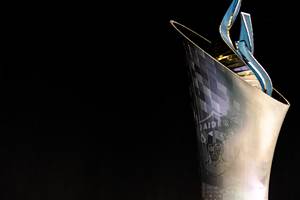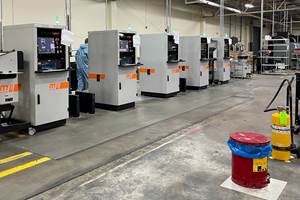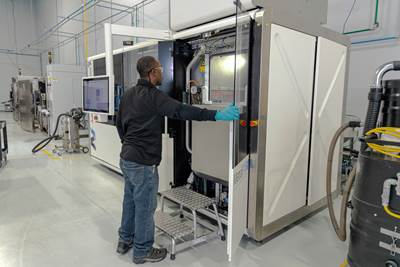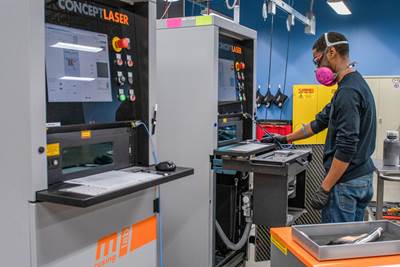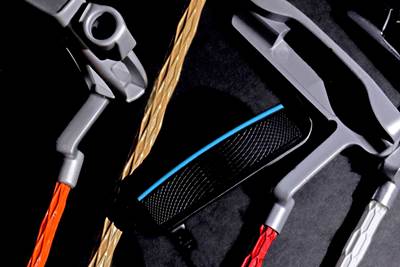In a collaboration between the industrial design and branding studio All Design Lab and contract manufacturer Protolabs, direct metal laser sintering (DMLS) was utilized to 3D print the complex geometry behind the frame for the tennis racket named Hìtëkw.
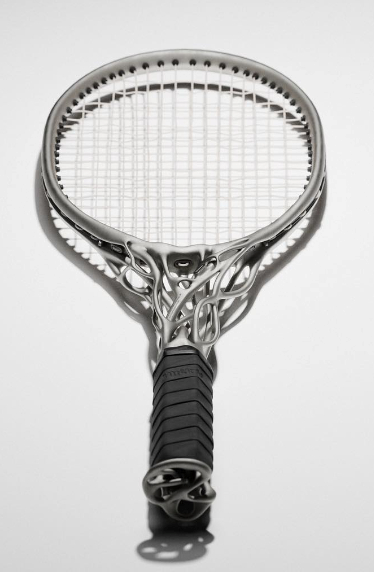
The Hìtëkw tennis racket frame was 3D printed as a collaboration between All Design Lab and Protolabs. The inspiration for the complex geometry behind the branch-like frame is the Lenape Native Americans’ use of natural resources such as wood.
Through equal parts communication from customer and manufacturer, Hìtëkw was designed and brought to life to challenge conventional design methods and utilize additive to achieve a functional and aesthetic end product.
I spoke with Anthony Lopez, co-founder of All Design Lab, and Chloe Vollaro, the applications engineer on the project for Protolabs, to learn more about how this complex design was built via reciprocal collaboration.
Conceptualizing the Design
Never before having created a concept for sporting equipment, All Design Lab drew inspiration for the racket that would become Hìtëkw from the 2022 U.S. Open in New York. The tournament happened to be taking place about 15 minutes away from All Design Lab’s studio location.
The design was intended to encompass historical storytelling, along with complex geometry the storytelling suggested. All Design Lab’s goal was to push the boundaries of traditionally produced tennis racket frames and create something new.
All Design Lab co-founders Anthony Lopez and Andrew Lim found their inspiration in the Lenape Native American tribe, whose members resided in the Northeastern United States during the 16th and 17th centuries, the site of the 2022 U.S. Open.
To honor the tribe’s homeland, the racket was designed to resemble what the Lenape created from trees and other resources native to their land.
Lopez experimented with AI generative design, and after various iterations, he landed on an intertwining, branch-like racket frame.
As the design progressed and became more complex, Lopez knew processes like CNC machining and injection molding didn’t have the capability to actualize the form.
But additive manufacturing did.
Collaborative, Additive Approach
After finalizing the design, All Design Lab wanted to make it a reality quickly and efficiently. Protolabs would 3D print the frame, named Hìtëkw, or the Lenape term for “tree.”
“We wanted to find a manufacturer that would work well with us and communicate every step of the way. Trusting in your manufacturer’s capabilities is critical. Knowing the racket frame was complex and required a large, continuous print, we needed someone we could really trust with this print job,” Lopez says.
The tennis racket All Design Lab designed was both durable and light. DMLS was selected as the 3D printing method because of Hìtëkw’s design complexity in the interwoven branches of the frame. The racket’s material is aluminum.
Protolabs Applications Engineer Chloe Vollaro served as one of the engineers on this project and worked closely with All Design Lab during the 3D printing process.
“We took a consultative approach toward 3D printing the tennis racket’s frame,” Vollaro says.
The first step in the collaborative process began with the photo renderings of the initial design and from here, the CAD files were generated. The original CAD files, however, did require some minor tweaks. “We try to be as proactive as possible when it comes to de-risking a build,” Vollaro says.
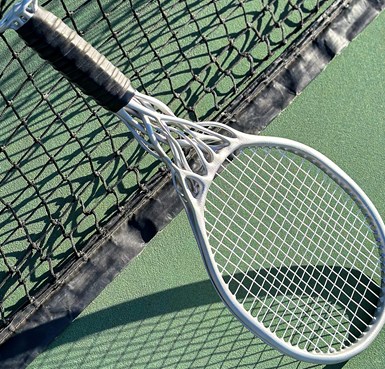
The Hìtëkw tennis racket frame was 3D printed on one of Protolabs’ larger DMLS machines to accommodate the length and height of the frame.The intricacy of the branch-like design is why additive was selected, to ensure the complex geometry would faithfully translate to the final product. Source: Protolabs
CAD can sometimes display a form that cannot physically exist. For example, the initial CAD file of the Hìtëkw frame had somehow managed to turn itself inside out.
“We reached out to [All Design Lab] to brainstorm how to best fix the issue causing this effect.” The solution involved hollowing out some of the part (not all — see below), which is “something you just can’t do with traditional manufacturing,” Vollaro says.
The next issue Protolabs addressed concerned holing, as the original design did not leave escape routes for powder.
Through a mutual back-and-forth between Protolabs and All Design Lab, the concern was quickly resolved. It was decided that solidifying the inner branches of the design (where free powder could build up) was the best course of action.
Getting the CAD file correct, crucial for any AM job, was particularly important here. The Hìtëkw frame is on the larger end for a build with Protolabs’ DMLS machines, with a height of more than 26 inches. The company has two metal DMLS machines able to accommodate this size of part — GE Additive X Line machines. Protolabs uses its two X Line machines for aluminum and Inconel. Aluminum was selected for Hìtëkw for lightweighting.
3D Printing Process
The Hìtëkw frame was successfully built in one single, continuous print.
While the larger DMLS machines can accommodate multiple parts (sometimes from different customers) on one build plate, the Hìtëkw frame was built by itself due to sheer size, and also for NDA purposes as footage of the print was captured during its build.
The build itself was relatively flat, utilizing a slight angle along with supports that would later be manually cut off. In part, because there was so little Z height, the entire build took roughly 30 hours.
Post-print, the frame went to stress relief.
Then, the part underwent wire EDM and was removed from the platform. From there, the support removal began. Protolabs’ metal finishers were careful to smooth and polish the build without damaging or compromising the final geometry.
“It’s big stakes. A small tool mark or accidentally cutting into the part’s geometry could have ended up costing thousands of dollars to reprint,” Vollaro says.
After the frame completed the postprocessing steps, the final product ended up weighing in at just shy of three pounds.
Game, Set, Match: Hìtëkw’s Future
Utilizing additive enabled All Design Lab to bring Hìtëkw’s concept into reality, achieving intricate functional geometry expressing artistic and historic elements. The collaboration between customer and manufacturer aided success.

The Hìtëkw tennis racket is on display at the Musée du Luxembourg in Paris, France, and serves as a powerful example of collaboration in AM. Source: Protolabs
3D printing the Hìtëkw frame successfully in one attempt was an important outcome, saving valuable time and preventing unforeseen costs.
“This project showed me how 3D printing offers endless possibilities to design very attractive, or strange and complex shapes that command attention,” Lopez says.
The functional prototype can be strung up and used like a traditional tennis racket, but its primary purpose is to display on tour at events within the international tennis community in both Europe and the U.S.
The racket will be featured at the Musée du Luxembourg in Paris, France, for the 2024 Summer Olympics until August 11, 2024. The exhibition celebrates design’s role in shaping the future of sports.
Hìtëkw serves as an example of the design possibilities within additive manufacturing, and the promise of future collaborations to come.
Related Content
The World’s Tallest Freestanding 3D Printed Structure
Dimensional Innovations paired additive and subtractive manufacturing to create a monument for the NFL’s Las Vegas Raiders new stadium. The “never been done before” project resulted in the world’s tallest freestanding 3D printed structure.
Read MoreDrones Take Flight with Metal and Polymer 3D Printed Parts: The Cool Parts Show Bonus
Drones produced by Cobra Aero now incorporate many 3D printed parts made through laser powder bed fusion and Multi Jet Fusion processes.
Read MoreSeurat: Speed Is How AM Competes Against Machining, Casting, Forging
“We don’t ask for DFAM first,” says CEO. A new Boston-area additive manufacturing factory will deliver high-volume metal part production at unit costs beating conventional processes.
Read MoreAdditive Manufacturing Production at Scale Reveals the Technology's Next Challenges: AM Radio #28
Seemingly small issues in 3D printing are becoming larger problems that need solutions as manufacturers advance into ongoing production and higher quantities with AM. Stephanie Hendrixson and Peter Zelinski discuss 6 of these challenges on AM Radio.
Read MoreRead Next
The Benefits of Vertically Integrating Metal 3D Printing and Machining
Having 3D printing and machining within one organization enables Addman’s engineers to collaborate and consolidate so it can quickly make successful metal 3D printed parts.
Read MoreProtolabs Opens New DMLS Facility to Meet Increasing Additive Demand
Protolabs recently opened the doors to its new DMLS additive manufacturing facility to support its customers’ growing demand for AM. The facility, built from the ground up, was designed to accommodate a smooth and safe workflow, continue expanding machine and technology offerings and promote burgeoning additive production.
Read More3D Printed Golf Putter Shafts: AM Tailors Weight Distribution for an Optimized Putting Stroke
Snarr3D offers high-performance golf putters with aesthetic features made possible through 3D printing. In manipulating the weight distribution of the golf putter shaft, Snarr3D aims to enhance accuracy and performance to give golfers the equipment suited to their individual game.
Read More


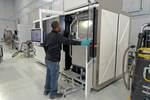








.png;maxWidth=300;quality=90)





